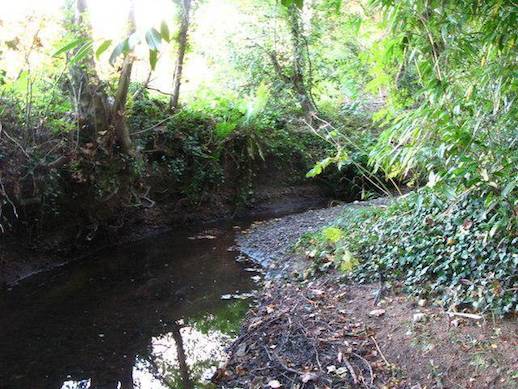 Kyd Brook. Photo: Mike Quinn
Kyd Brook. Photo: Mike Quinn
Words: Nina Lyon
When I was a kid we played in the stream by the Troll Bridge. The supernatural power of the troll to sublimate into shadow at the approach of footfall made me feel better about the bridge: it threw all those myths about trolls proactively seeking out goats into correct absurdity. We were safe in its presence, top predators.
The Troll Bridge spans the Kyd Brook, which at that point is a stream, and was, is, barely even a stream during the frequent hot summers of greater London. Its bed is wide enough to leap across and I have rarely seen it too deep to cross in child-size wellies. It is a Lilliputian little trickle of a brook which, much further down the line when it has joined the Quaggy and then the Ravensbourne, still somehow trickles slowly and with silty recalcitrance into the Thames at Deptford.
I changed at Lewisham to get the DLR into Greenwich to go to a psychedelics conference a few weeks ago and took childish delight in the view from the elevated line, which reveals the course of the end of the river in a way that the streets never did before the DLR existed. There’s something about running along a tiny stream before breakfast and seeing it all grown up, at its endpoint, a couple of hours later that is oddly satisfying. I saw a woman in waders in the river at Deptford Creek, looking industrious with a net. Even there it was barely knee-high.
At the psychedelics conference, one of the speakers was talking about enchantment. He meant a sense of wonder by it, a sense of the magical unfolding of detail embedded in all things that was, or at least seemed, lost to industrial society. The reason people take psychedelics, everyone seemed to agree, is to rediscover it. There is a drive within us, often dampened and trampled by adult life, that still seeks enchantment.
I had it as a kid in the Kyd Brook, creating ambitious dams with pebbles so that the stream took new deviations, and hiding in the hollows of the trees so that the scale of the whole enterprise grew into a world that was many times bigger than a brook you could stand in in your shoes and cross in one jump. Even the pebbles themselves, which in that part of Kent are brittle and flinty with insides like colour-specked glass, held an hour of getting lost in them. The Kyd Brook, I imagined, would be navigable in its entirety in a raft made out of sticks if we could only have a week of heavy rain, which never materialised.
I ran along it again. Hawkwood, the part near my childhood home, is maintained by the National Trust and has the immaculate quality of Home Counties countryside: perfectly golden fields with cattle seemingly selected for their looks, tree-lined paths that are somehow never overgrown, dusty-floored woodlands of oak and holly. A peacock crossed my path on the hill, standing in full sun so that I had to leap over his tail. I stopped running.
In the hedgerow there were sloes and blackberries. I stopped to eat the blackberries, which were already ripe, months earlier than they would be back home in Wales. I walked slowly now, and turned right instead of left, heading away from home to where the woods thickened towards Scadbury, and paused to climb the bottom bit of a tree and look back at the wavering greenness of the edge of the city, and thought about enchantment again.
After you decide to stop being enchanted in order to stop being a child, and realise that something is missing, there are various ways back in. Once upon a time, psychedelics offered a shortcut, and perhaps they still do. But there are other, slower ways. You simply need time and space to acclimatise into the scale of enchantment, which is found when small things can start to become large again. The slowness of time in the natural world lends itself to enchantment far better than the instant-access novelty of technological life. I’d met far too many people that day who’d paid to hire shamans in Peru in the interest of accessing their particular mode of enchantment, and the idea of it seemed a bit silly now. It was here, open-access, unmedicated. It just needed a suspension of time.
On the way home there were voices by the Troll Bridge. A bit further down from where I used to play, some kids were dangling from a rope swing. It was getting dark, past nine and past their bedtime, and it felt as though all was well.
Nina will be joining us at The Good Life Experience in September, reading from her first book, Uprooted: on the trail of the Green Man, due to be published by Faber in March 2016.